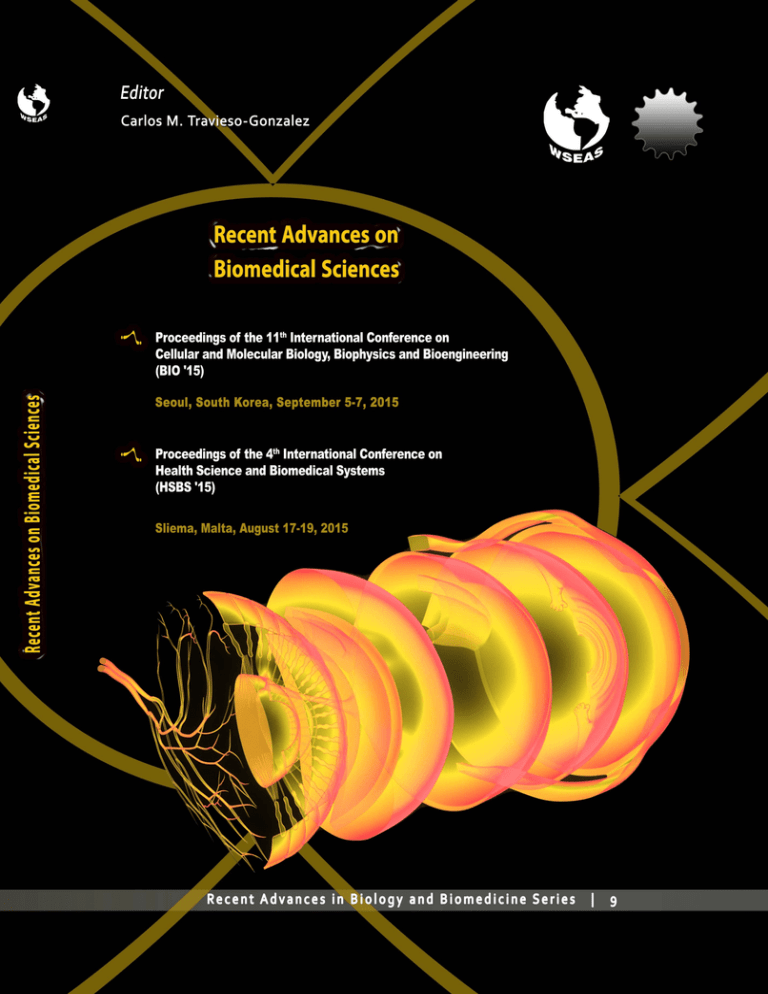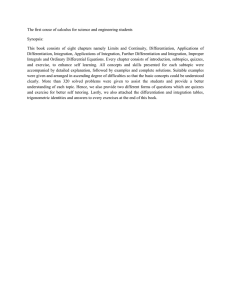
RECENT ADVANCES on BIOMEDICAL
SCIENCES
Proceedings of the 11th International Conference on Cellular and Molecular
Biology, Biophysics and Bioengineering (BIO '15)
Seoul, South Korea
September 5-7, 2015
Proceedings of the 4th International Conference on Health Science and
Biomedical Systems (HSBS '15)
Sliema, Malta
August 17-19, 2015
Recent Advances in Biology and Biomedicine Series | 9
ISSN: 1790-5125
ISBN: 978-1-61804-334-4
RECENT ADVANCES on BIOMEDICAL
SCIENCES
Proceedings of the 11th International Conference on Cellular and Molecular
Biology, Biophysics and Bioengineering (BIO '15)
Seoul, South Korea
September 5-7, 2015
Proceedings of the 4th International Conference on Health Science and
Biomedical Systems (HSBS '15)
Sliema, Malta
August 17-19, 2015
Published by WSEAS Press
www.wseas.org
Copyright © 2015, by WSEAS Press
All the copyright of the present book belongs to the World Scientific and Engineering Academy and
Society Press. All rights reserved. No part of this publication may be reproduced, stored in a retrieval
system, or transmitted in any form or by any means, electronic, mechanical, photocopying, recording, or
otherwise, without the prior written permission of the Editor of World Scientific and Engineering Academy
and Society Press.
All papers of the present volume were peer reviewed by no less that two independent reviewers.
Acceptance was granted when both reviewers' recommendations were positive.
ISSN: 1790-5125
ISBN: 978-1-61804-334-4
RECENT ADVANCES on BIOMEDICAL
SCIENCES
Proceedings of the 11th International Conference on Cellular and Molecular
Biology, Biophysics and Bioengineering (BIO '15)
Seoul, South Korea
September 5-7, 2015
Proceedings of the 4th International Conference on Health Science and
Biomedical Systems (HSBS '15)
Sliema, Malta
August 17-19, 2015
Editor:
Prof. Carlos M. Travieso-Gonzalez, University of Las Palmas de Gran Canaria, Spain
Committee Members-Reviewers:
Kamal Emam
Magdy Gebril
Adel Gad
Mohamed Sayed Salama
Akila M. El-Shafie
Bahira El-Sawaf
Dalia A. M. Salem
Nadia Helmy
Mona Salah Eldin Hassan Talaa
Abdelsattar Mohamed Sallam
Mahmoud El-Sayed
Mohamed Ismail Roushdy
George Barreto
Athanassios Stavrakoudis
Kalaivani Doraisamyraja
Mahboobeh Mahmoodi
Jose Alberto Duarte Moller
Babak Khalili Hadad
Hugo Cruz-Suarez
Panagiotis Gioannis
Azlinah Mohamed
Sorinel Oprisan
Ozlem Coskun
Mohammad Al-Amri
Montri Phothisonothai
Pedro Nucci
Karel Allegaert
Svetla Vassileva
Tiberiu Socaciu
Diana Cotoros
Howe Hing Tang Collin
In?cio Fonseca
Carlos Rivas-Echeverria
Haiam Aboul Ela
Antigona Trofor
JainShing Wu
Zengshi Chen
Vinod DS
Yoshiyuki Tohno
Manjunath KN
Mihai Caramihai
Alexander N. Pisarchik
Md. Shamim Akhter
Krishnaveni Marimuthu
Khin Wee Lai
Dhaval Vyas
Carla Pinto
Corina Carranca
Claudia A. F. Aiub
Muhammad Musaddique Ali Rafique
Tsvetelina Draganova
Daniela Cristina Momete
Sk. Sarif Hassan
Mansooreh Shariatmadare Tehrani
Yuqing Zhou
Hongjun Liu
Dana Anderson
Serban Corina
Walid Oueslati
Ming-Shen Jian
Marcio Dorn
Theodoros Xanthos
Yong Kheng Goh
Table of Contents
Plenary Lecture 1: Control Functions and Bipolar Potentials in Excitatory Cells Characteristics of Neuron and Unicellular Organism
Atsushi Fukasawa
9
Plenary Lecture 2: The Usage of Liver Extract Versus Growth Factors in the Differentiation of
Mesenchymal Stem Cells into Hepatocyte Like Cells
Shaden Muawia Hanafy
10
Phase Space Reconstruction of Optogenetic Data
Sorinel A. Oprisan, Tamas Tompa, Patrick E. Lynn, Antonieta Lavin
11
Activity of a Neuron for Characteristic Potential Waveforms of Pulse and Plateau with Positive
and Negative Polarities
Yumi Takizawa, Atsushi Fukasawa, Kazuhiko Natori
20
Fully Automatic Segmentation and Detection of Pulmonary Artery and Embolism in CTA
Images
Jamshid Dehmeshki, Y. Ebrahimdoost, S. D. Qanadli
28
Laryngograph as a Tool in Diagnosis and Therapy of Voice Disorders
Jolanta Zielińska, Ewa Brzdęk
34
A Computational Study of a Prebiotic Synthesis of L-Tyrosine
Nigel Aylward
39
Statistical Methods in Healthcare Management: Case Study of Slovenian Clinic
Nadja Damij, Franc Jelenc, Jana Suklan
47
Positive and Negative Action Potentials in Paramecium Relating to Neurons
Yumi Takizawa, Atsushi Fukasawa, Hiro-aki Takeuchi
54
Oxidative Stress in Diabetes: Ammonia Breath Analysis by Laser Photoacoustic Spectroscopy
Mioara Petrus, Ana-Maria Breatu, Cristina Popa
61
Activity of a Neuron for Generation of Pulse and Plateau with Positive and Negative Potentials
Atsushi Fukasawa, Yumi Takizawa
65
Biomedical Applications of CO2 Laser Photoacoustic Spectroscopy
Cristina Popa, Mioara Petrus, Ana M. Bratu
72
A Computational Study of a Prebiotic Synthesis of L-Valine
Nigel Aylward
75
Do Excel and iGrafx Provide the Same Healthcare Process Simulation Results?
Nadja Damij, Franc Jelenc, Biljana Mileva Boshkoska
81
Investigation of Mechanical Properties of a Biocompatible Film from Riboflavin and Gelatin
Bariş Demirbay, Gülşen Akin Evingür, Fatma Gülay Acar
88
The Viscosity Behavior of Biocompatible Solutions Including Riboflavin and Gelatin
Bariş Demirbay, Fatma Gülay Acar
91
DaVinci System, a Partner or just a Tool?
Săvulescu Florin, Cîrlan Cristian
95
Activity of Bipolar Potential Generation in Paramecium
Yumi Takizawa, Atsushi Fukasawa, Hiro-aki Takeuchi
98
Preparation of Chitosan Magnetic Nanoparticles Loaded Recombinant Tissue Plasminogen
Activator for Targeted Thrombolysis
Jyh-Ping Chen, Hao-Lung Hsu
105
HLA-C Gene in Hepatitis C Virus Infected Patients in Egypt, to Estimate the Relation Between
HLA-C Gene and Interferon / Ribavirin as Treatment for Hepatitis C Virus
Shaden Muawia Hanafy, Amal Ahmed Abbas, Safy Kabeel Aly Mansour
112
Measurement of Intra-Abdominal Fat Thickness Using Ultrasound for Visceral Fat Estimation
Robby Hermawan, Irma H. Hikmat, Ristaniah D. Soetikno, Eko Supriyanto, Saravana Kumar
Jaganathan
118
Binaural Beat Entrainment Effect on Prefrontal and Parietal Brain EEG in Theta Frequency
Muhammad Wildan Gifari, Sheikh Mohamad Said, Jostinah Lam, Noraini Jalil, Eko Supriyanto
124
Evaluation of Cardiac Markers Using Radar Chart
Tay Yii Cheng, Mochrosin, Muhammad Haikal Satria, Eko Supriyanto, Jasmy Yunus
130
Nonlinear Patterns During the Temporal Organization of Self-Initiated Movement
Juliana Dushanova
137
Reduction Mercury-Polluted Water in Gold Mine with Anaerobic Bacteria
Prima Endang Susilowati, Sapto Raharjo, Rachmawati Rusdin, Misrawati, Siti Nur Hajiran, Sarfina,
Muzuni
142
Fabrication of Porcine DNA Biosensor Based on [Ru(bpy)2PIP]2+ Complex
Nurul Izni Abdullah Halid, Haslina Ahmad, Lee Yook Heng, Nurul Huda Abd. Karim, Siti Norain
Harun, Siti Aishah Hasbullah
147
Biological Activity of Minimal Dose of Aerosolized Interferon-α in Male Albino Rats
Khalil A. El-Halfawy, Shaden M. Hanafy, Bahgat A. El-Fiky, Hassan M. Hassan
150
Authors Index
157
Plenary Lecture 1
Control Functions and Bipolar Potentials in Excitatory Cells – Characteristics of Neuron
and Unicellular Organism
Professor Atsushi Fukasawa
Institute of Statistical Mathematics
Japan
E-mail: takizawa@ism.ac.jp
Abstract: Secretary, muscle, and neural cells in multicellular organism induce excitations for stimulations. Upon
reception of external or internal stimulation, potential pulses are induced in excitatory cells when reception potential
exceeds threshold. Unicellular organisms are the other type of excitatory cells.
He will present first how unicellular organisms control cilia of paramecium and tentacles of noctiluca. Forward or
backward movements by cilia of paramecium, and expansion or contraction of food gathering tentacles of noctiluca
are controlled by positive and negative potentials generated in a single cell.
Recently not only positive potential (pulse and plateau) but also negative potential plateau are reported in studies in
neural systems. Common basis of activity in neurons will be presented on dual configuration with Na+ and Cl- as the
dominant charges (ions) for bipolar action potentials.
Brief Biography of the Speaker: Atsushi Fukasawa received the Master of Arts degree and Ph.D. degree from
Waseda University in 1967 and 1983. He was a professor in Graduate School of Natural Science, Chiba University in
1997. He received the Award of the Agency of Science and Technology, Japan in 1982, and Ohm (publisher) Prize in
1994. He received Telecommunication System Technology Prize from the Foundation of Telecommunication
Association, Japan in 2004. He is a senior member of the IEEE.
Dr. A. Fukasawa and his colleague, Dr. Y. Takizawa are the recipients of the Best Paper Award of Neurology’12,
SummerMed., WSEAS/NAUN, July 2012.
Plenary Lecture 2
The Usage of Liver Extract Versus Growth Factors in the Differentiation of Mesenchymal
Stem Cells into Hepatocyte Like Cells
Professor Shaden Muawia Hanafy
Genetic Engineering and Biotechnology research Institute
Department of Molecular Biology
Sadat City University
Egypt
E-mail: shadenmuawia@yahoo.com
Abstract: Liver cell transplantation and cellular-based therapies evolved as viable clinical alternatives to whole organ
transplantation required in some liver diseases. Differentiation of stem cells into hepatocyte like cells would provide a
renewable source of exogenous hepatocytes for drug toxicity testing and cell-based therapeutics. Many protocols of
in vitro differentiation of stem cells into hepatocyte like cells had been employed to check the ability of differentiation
as well as the functional efficacy of differentiated cells. But still the exploration of an easy and affordable one is
needed to facilitate MSC differentiation into hepatocytes. In this study, we employ three different protocols of
differentiation of bone marrow mesenchymal stem cells (MSCs) into hepatocyte-like cells with a view to developing
easier and affordable protocol using liver extract verses expensive growth factors cocktails. MSCs were isolated from
rat?s bone marrow using the plastic adherence technique. Cells were then sub-cultured till passage 3 for their
purification and proliferation. CFU-F assay and immunological characterization was done through the flow cytometric
analysis of CD29, CD90 and CD45 surface markers. Flasks then were divided into four groups, first; control group
cultured in proliferative media. Second group; cells cultured in hepatocytic differentiation media 1 (HDM) 1 containing
FGF-4. Third group; cells cultured in HDM2 containing FGF-4 and HGF and finally fourth group; cultured in HDM3
containing liver extract instead of the previously mentioned growth factors. Cells were tested for their differentiation
morphologically and functionally through assessing Urea secretion, glycogen storage and gene expression of albumin
by RT-PCR. Flow cytometric analysis showed that after passage 3, the cells do not express hematopoietic marker
CD 45 but express the two mesenchymal markers CD29 and CD90. Cells cultured in HDM2 and HDM3showed
morphological changes of hepatocyte like cells in day 12 and day 15 respectively, these changes didn?t appear
neither in control group nor in cells cultured in HDM1. Urea production and secretion by hepatocytes like cells were
detected at various time points throughout differentiation. In the HDM 2 and 3 groups cells produced urea 3 d later,
and in a time-dependent manner. On d 24, the amount of urea produced by differentiated bone marrow cells reached
the maximum amount and was detected with a concentration of 23.06±11.9 mmol/L on HDM 2, and 20.89±10.44
mmol/L on HDM 3. Cells in the control and HDM 1 groups did not secret any urea. Intracellular glycogen
accumulation was analyzed by staining the cells with the PAS reagent. On d 24 accumulation of glycogen was
detected in the HDM 2 and 3, while no accumulation of glycogen was found in the other groups. Albumin mRNA was
detected by RT-PCR, the results showed that the cells cultivated in HDM 2 and 3 expressed albumin, while in control
group and HDM 1 did not. The usage of liver extract in the differentiation of MSCs into hepatocyte like cells proved to
be almost as effective as the usual used cocktail of HGF and FGF, yet more affordable and easier approach, thus
useful in providing a renewable source of exogenous hepatocytes for drug toxicity testing and cell-based
therapeutics.
Brief Biography of the Speaker: Dr Sh. Muawia holds a BSc in Biochemistry from Faculty of Science- Alexandria
University-Egypt. She holds a Master degree & a PhD in Biochemistry (1992, 2001 respectively) from the Faculty of
Science- Alexandria University. She works as a Professor of Biochemistry and Molecular Biology in the Molecular
Biology department in Genetic Engineering and Biotechnology research Institute (GEBRI) - Sadat City UniversitySadat City. She is the vice dean of the environmental affaires and community services in the GEBRI.
Her research interests include: Apoptotic signaling pathway and apoptotic markers in different tumors ( adult acute
myeloid leukemia and in Hepatocellular Carcinoma) and in HCV patients. Single nucleotide polymorphism and gene
expression of different genes in various diseases and tumors. Oxidative stress and antioxidant defence beside
cytokine expression on the molecular and protein levels. She has 30 publications in highly rated ISI journals and
attend 38 conferences.


